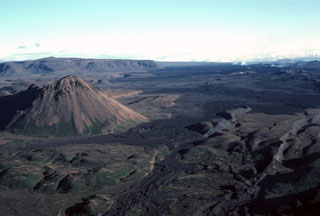Report on Krafla (Iceland) — January 1978
Scientific Event Alert Network Bulletin, vol. 3, no. 1 (January 1978)
Managing Editor: David Squires.
Krafla (Iceland) New inflation event 6-22 January
Please cite this report as:
Global Volcanism Program, 1978. Report on Krafla (Iceland) (Squires, D., ed.). Scientific Event Alert Network Bulletin, 3:1. Smithsonian Institution. https://doi.org/10.5479/si.GVP.SEAN197801-373080
Krafla
Iceland
65.715°N, 16.728°W; summit elev. 800 m
All times are local (unless otherwise noted)
Renewed deflation at Krafla began on 6 January and continued through 22 January. Uplift then resumed and was continuing in early February.
On 6 January at 1700 the continuously recording tiltmeter at Krafla started to show slight deflation towards the N. The next morning at 0700, the rate of deflation increased and half an hour later harmonic tremor began. The rate of deflation (9.4 µrad/hour) was considerably slower than in previous events. In the following hours, it became evident from earthquake locations that magma injection into the fissure system N of Krafla was occurring. Epicenters migrated to 30 km N of Krafla on 7 January and had migrated 10 km farther N by the 9th, affecting the December 1975 rift zone (Björnsson and others, 1977). The number of earthquakes gradually decreased 8-10 January, but magnitudes increased, reaching a maximum of 4.8.
Deflation ended 22 January after subsidence equivalent to about 110 cm had been recorded. Uplift then resumed, but has been interrupted several times, coinciding with periods of volcanic tremor. Earthquakes, many with magnitudes greater than 4, were continuing in early February from the rift zone, 25-50 km N of Krafla. The amount of rifting has not been measured, but about 2 m were added to telephone lines crossing the rift zone. Roads crossing the rift zone became impassable on several occasions, and one farmhouse was seriously damaged due to the opening of a ground fissure beneath it. No marked change in geothermal activity has been observed, and no visible eruption has occurred.
Geological Summary. The Krafla volcanic system in the Northern Volcanic Zone (NVZ) of Iceland is about 100 km long, consisting of a fissure swarm and a central volcano with a 7 x 9 km caldera formed about 110,000 years ago that deposited a rhyolitic welded tuff. It has been moderately active in the Holocene, over three distinct eruptive periods; the current one has lasted about 2,800 years with six volcano-tectonic episodes, each with one or more basaltic fissure eruptions. Lava volumes (DRE) have been in the 0.1-1 km3 range. The Hverfjall and Ludent tuff rings east of Myvatn were erupted along the fissure system. Myvatn lake formed during the eruption of the older Laxarhraun lava flow from the Ketildyngja shield volcano of the Fremrinamur volcanic system about 3,800 years before present (BP); The present Myvatn lake is constrained by the roughly 2,000 years BP younger Laxarhraun lava flow from the Krafla volcanic system. The abundant pseudocraters that form a prominent part of the Myvatn landscape were created when the younger Laxarhraun lava flow entered the lake. The last eruption took place in 1975-1984 CE when nine small basaltic fissure eruptions produced 0.25 km3 of lava.
Information Contacts: G. Sigvaldason, NVI.

